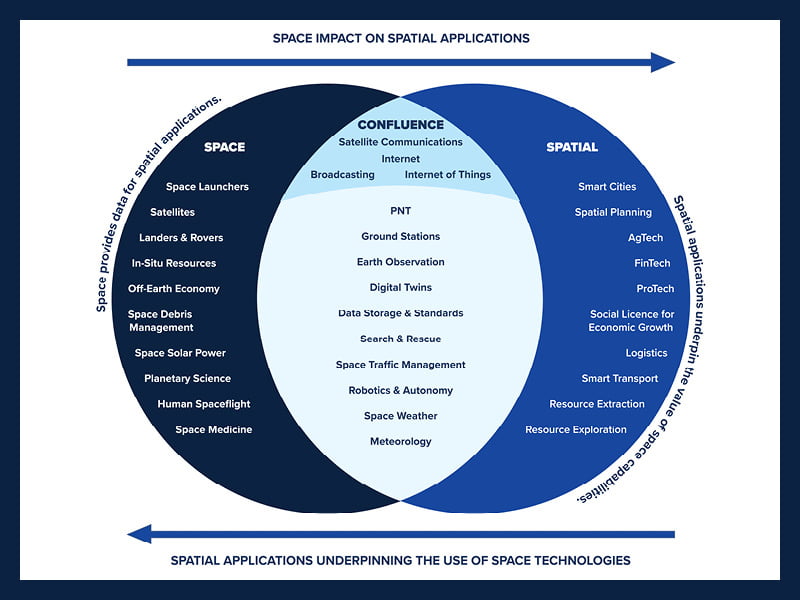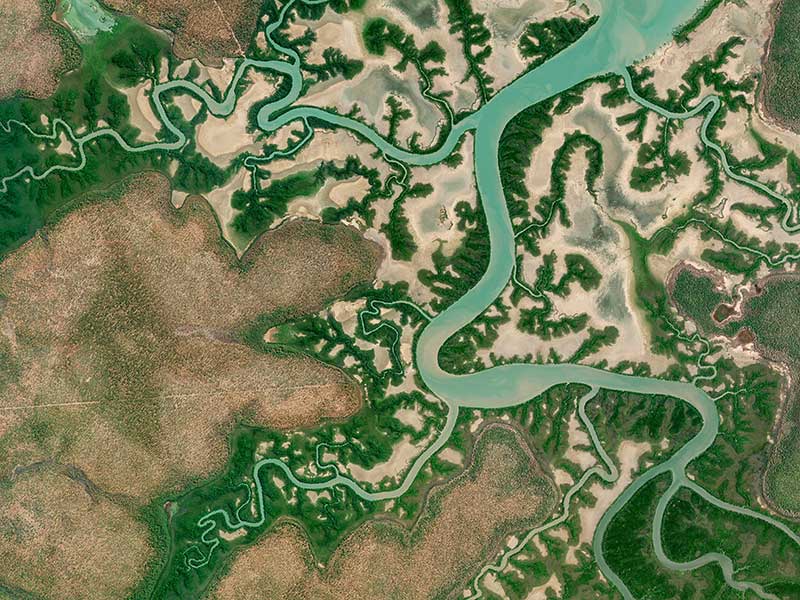The space industry and its intertwined cousin the spatial industry are rapidly becoming a hotbed of innovation globally. Together they are developing the fundamental technology, data sources and products that are driving sweeping changes to the technological framework of the future.
Australia has the capability to join this wave, with the potential to achieve significant economic and productivity outcomes and secure access to critical data streams essential to Australia’s future.
The space and spatial industries already provide many key services that underpin our modern technological world, including telecommunications, weather forecasting, mapping and location services, that enable us to navigate easily and accurately.

Innovation in these industries is already shaping the future by developing the technology and data for:
- precision agriculture to increase productivity and crop yield;
- precision positioning to increase efficiency in construction and mining;
- understanding climate change (32 of the 54 essential climate variables used to monitor climate change can only be obtained from space): and
- increasing delivery service efficiency based on driverless cars and drones.
These innovations – as well as the harvesting of planetary resources, generation of space-based solar power and development of an off-earth economy – are placing the space and spatial industries among the major growth markets for the coming decades.
The global space industry alone is projected to grow from US$350 billion today to $1.1 tn by 2040 and the geospatial industry is expected to more than double that.
Australia already has pockets of competence and excellence in the space and spatial sectors but lags its Organisation for Economic Co-operation and Development (OECD) cohort. Australia risks missing out on the tremendous economic growth and structural efficiencies that these industries can deliver.
The challenge for Australia is to build an innovation and research framework with sufficient critical mass to capitalise on the global opportunities of the space and spatial industries. If we can do this, Australia will be able to fully participate in the economic growth and efficiencies of these future technologies.
The alternative is that Australia continues to languish in the lower echelon of the OECD with increasing reliance on ‘friendly nations’ for critical data and services essential to the well-being of Australians over the next decade and beyond.
The space industry covers the satellites in space, the launch services that take them to space, the ground stations that downlink the data and the services derived from that data.
Satellites provide us with ubiquitous communication services, crucial navigation services and split-second timing services for all financial transactions.
Less well known is the spatial industry which transforms the vast streams of positioning data and satellite images into essential day-to-day services such as navigation maps, weather maps, location of fire fronts and many more products.
Spatial science uses smart algorithms to add high value insight into the products from satellite data streams. These spatial databases are crucial for Australia’s digital future and need to be carefully curated in next generation data infrastructure systems for open access and use.
Australia’s modern society is highly dependent on communications and data derived from satellites. Yet few people realise that Australia has almost no satellites of its own – we have only a handful of communications satellites, some recently launched small satellites providing IoT data and a few experimental cubesats from universities.
Australia owns no satellites that routinely provide earth observation images or Position, Navigation and Timing (PNT) data.
Earth observation imagery provides us with a continuous stream of data for weather forecasting from around a dozen foreign satellites. Satellite-based PNT (think GPS) now underpins around US$2tn per annum of economic activity worldwide.

Even short disruptions are predicted to cost around US$1 billion for countries like the US and UK with devastating consequences for emergency services, banking and finance systems, and mobile communications.
Australia currently must rely on the goodwill of foreign owners or on their willingness to allow us to buy data from their satellites. Relying on others to provide these essential services is a sovereign risk and critical vulnerability.
However, we can transform this sovereign risk into a golden opportunity to position Australia as a global space and spatial leader of the future.
The key to accelerating innovation in the space and spatial industries, while simultaneously mitigating sovereign risk, is through an ongoing series of national space missions underpinned by a long-term strategy and capability blueprint.
Globally competitive sovereign Australian space and spatial industries will give Australia the capability and capacity to:
- provide the nation with its critical sovereign space and spatial needs, including assured access to space and greater self-sufficiency in national defence;
- execute complex space projects in Australia, and make substantial technical, operational and management contributions to international missions;
- provide global leadership in integrating the space and spatial domains and create market opportunities in adjacent and emerging disciplines (including data-driven decision-making, artificial intelligence, precise positioning in real time, remote operations, artificial intelligence, machine learning, spatial digital twins, optical communications and quantum technologies, among others);
- increase productivity and capture a much larger share of the rapidly growing global space and spatial markets;
- be a destination of choice for space and spatial specialists and companies and highly attractive for new space and spatial startups;
- be recognised as a key provider of research, education and training in space and spatial sciences and technologies with a highly skilled workforce that achieves the required critical mass for recognition and growth; and
- underpin critical supply and value chains across the whole Australian economy.
A long-term strategy will guide Australia’s growth into a global space and spatial powerhouse.
Developing an understanding of required sovereign capabilities, coupled with favourable policy settings and well-designed long-term national missions, will establish the framework needed for Australian entrepreneurs and innovators to attract the patient global capital required to create the supply and value chains.
A national space and spatial industry blueprint will enable us to meet far more of our own needs. It will see us increase our domestic productivity and attract international contracts to capture a much greater share of the rapidly growing global space economy. An economy which will play such a crucial role in the future technological world.
By acting with pace and purpose over the coming decades, Australia can secure a preferential share of the huge global growth in the space and spatial industries while safeguarding national needs.
Dr Peter Woodgate is Chair of SmartSat Cooperative Research Centre, Chair of the Steering Committee for the 2030 Space and Spatial Industries Growth Roadmap, member of the Australian Space Agency’s Space Industry Leaders Forum, board member of the Public Sector Mapping Agency, Chair of the Australian Urban Research Infrastructure Network and Chair of Canthera Discovery. Peter has been involved with the space and spatial industries for more than 30 years. He is an Honorary Fellow of the Surveying and Spatial Sciences Institute and a life member of the International Society for Digital Earth.
William (Bill) Barrett is Senior Vice President, Asia Pacific Aerospace Consultants (APAC) advising space companies from multinationals to start-ups. He has 25+ years’ experience across all major space sectors including satellite manufacture, communications, ground stations, launch services, space insurance and space policy. He regularly advises the Australian Government on space (expert at UNISPACE III, Hayabusa2 asteroid sample return, co-author of multiple space studies including the Space Workforce Skills Gap Analysis). He is co-founder and long term Deputy Chair of the Space Industry Association of Australia (SIAA), recipient of the SIAA lifetime service award and a space innovation supporter assisting more than 12+ start-up space ventures.
Dr Allison Kealy is the Executive Director Surveying and Spatial in the Victorian Department of Environment, Land, Water and Planning. Prior to this she was a Professor of Geodesy and Satellite Positioning in the School of Science at RMIT University. With more than 25 years in academia, Allison has also held roles as the Acting chief research office and research program director in the SmartSAT Cooperative Research Centre and Deputy Director of the Sir Lawrence Wackett Centre RMIT’s Defence research Centre. She is a Fellow of the International Association of Geodesy, and of the Royal Institute of Navigation. She is a technical representative to the Satellite Division of the US, Institute of Navigation.
Do you know more? Contact James Riley via Email.
